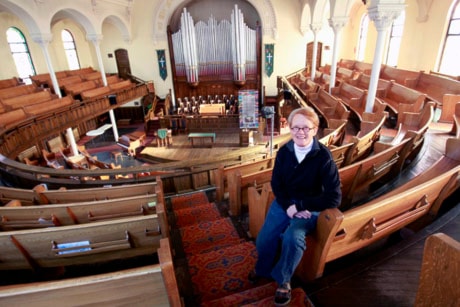WINNIPEG — Like any good hosts, the people of a Winnipeg church go out of their way to make their guests feel at home.
The Crescent Fort Rouge United Church congregation has rejigged the sound system, installed permanent spotlights, enlarged their stage and built new main-floor washrooms, all in a bid to make their building welcoming to local arts groups.
“The congregation here sees the building having a ministry to the community. One of the gifts big inner-city churches have is the gift of space,” explains the church minister, Rev. Barb Janes.
“We’re happy to invite the neighbourhood in to experience the beautiful space.”
Blessed with a century-old sanctuary with fabulous acoustics, a high ceiling, and seating for 400 on the main level and another 400 on the wrap-around balcony, Janes’ congregation invites in the neighbourhood for their own cultural program of drama, films and music and anytime they rent their building as a concert venue to music groups.
Janes says opening their doors to the public for concerts and other arts events is a balancing act between accommodating the outside groups and running their own church functions. Convinced her congregation wasn’t the only one in that situation, she researched how other congregations relate to arts groups, visiting churches in Saskatoon, Hamilton, Kingston and Cleveland, Ohio, during a recent three-month sabbatical.
What she found is that congregations who host arts groups play to their strengths. If they have space for visual arts, they hang paintings, but if they can offer great acoustics, they will host concerts. Some congregations screen the type of groups they host, while others, like St. James Anglican Church in Saskatoon, which has converted its parish hall into a not-for-profit arts centre called The Refinery, have a more arm’s-length relationship with neighbourhood groups.
Janes says being hospitable means being generous about who uses the space and not assuming concert-goers will ever show up for Sunday morning worship.
“I think for me it is similar to our mission to feed the hungry,” she says. “You do it because it is the right thing to do, not because we hope they come to church.”
But opening up the venue has unexpected rewards. For the last several years, local rock, punk, metal and acoustic bands have played Crescent Fort Rouge on weekend nights, usually to small but supportive audiences, explains church member Bill Gillis, who hosts the events. He says many of the band members have never been inside a church before and are overwhelmed they are welcome to play their music inside a traditional sanctuary outfitted with pews, stained-glass windows and a pipe organ.
“Lots (of them) go away with their ill-conceived ideas of church as shaken as the foundations of CFR (Crescent Fort Rouge) may be by the loudness of the music,” he writes in an email message. “They are deeply appreciative of what’s happening here.”
Hosting local music groups is much more than a business relationship, says Rev. Robert Campbell of Westminster United Church, a popular concert venue for more than a dozen choral groups, and the permanent home for the Manitoba Chamber Orchestra.
Tens of thousands of people visit the church annually as concert-goers or performers, and recently the church has been trying to bridge the gap between performance and worship by inviting the professional musicians to play during their Sunday service.
“For some of our people who are regulars in church and regulars in chamber orchestra, it provides an opportunity to hear him in a different setting and to hear him in prayer,” says Campbell of a recent Sunday morning visit by MCO cellist Yuri Hooker and one of his students
But groups who rent these spaces have mixed feelings about these venues, says Mike Thompson, president and manager of the Winnipeg Boys’ Choir and founding member of Camerata Nova, an early music group, both which have rented Crescent Fort Rouge.
“We go into this with our eyes wide open knowing these are churches,” says Thompson, a former boy soprano. “But as artists we long for a non-sacred space for choral groups.”
Campbell says United churches often make great choral venues because they were designed as auditoriums with a pulpit in the middle of the platform with the choir located directly behind. He says the wooden pews also contribute to good acoustics, but they can also leave concert-goers squirming during a long set, which is why Westminster United collaborated with MCO on seat cushions to soften the impact of a long concert.
Thompson says arts groups factor in the less comfortable seating when they plan the length of their programs at church venues, as well as realizing some potential audience members may not feel comfortable in a church setting. He says renting a church as a concert venue can offer advantages that make up for the shortcomings around seating.
“It is really nice getting into a space like that and doing something else in it than it was intended for,” says Thompson, who sings tenor in Camerata Nova. “You’re bringing people into the church who might never go to the church.”
Janes sees several benefits in hosting arts groups: income from rental fees, a sense that the building is being used on more than Sunday mornings, and the opportunity to interact with artists. She says every time the pulpit is rolled to the side and the platform is cleared to make room for a choir or an orchestra, there’s a potential to learn from the group performing on stage.
“I think having the mobility to move the furniture and transform the space with still having the ability to speak to our spirits gives us new ways of seeing the world,” says Janes.
“The role of the artist is like the role of the preacher: to open up something and catch a glimpse of a better world.”
